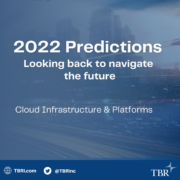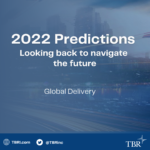Native PaaS services delivered via hybrid architectures shape the cloud market in 2022
Vendors innovate in PaaS, a cornerstone of investment for more mature enterprise customers looking to control costs, build client-facing solutions and generally drive business outcomes, post-migration. Throughout 2022, cloud service providers (CSPs) have continued to recognize that PaaS services are only as effective as the architecture they run on, which for many customers, includes multiple different clouds, edge locations and data centers.
Despite the negative impacts that inflation and unfavorable currency translation are having on vendor financials, the pace of PaaS investment will progress through 2023 as vendors look to compete in a saturating market and address what customers so clearly demand: choice, flexibility and freedom from vendor lock-in.
Prediction No. 1: Hybrid remains the new norm
Senior Analyst Catie Merrill: It is no secret that hybrid cloud is emerging as the preferred IT delivery method for enterprises, with scalability, choice, and diversification of assets among the leading benefits. Over the past several months, we have had conversations with customers across industry verticals highlighting this trend, and according to TBR’s 1H22 Cloud Infrastructure & Platforms Customer Research, 24% of respondents plan to move toward an entirely hybrid cloud environment in the coming years.
Throughout 2022, global economies have been grappling with heavy inflation and a strong U.S. dollar, and ongoing uncertainty around the economy may stall some hybrid implementations through the remainder of the year. However, our findings also indicate that unlike in the early days of cloud, cost is becoming less of a determining factor when choosing to move workloads off premises. As a result, many enterprises will progress with migrations, despite high prices, to supplement their data center investments and get the right solution tailored to their specific business goals.
In today’s market, hybrid cloud has largely come to encompass multicloud, another factor that has impacted adoption through 2022 is the tight labor market, including the ongoing skills shortage in IT. While the labor market does appear to be softening slightly, customers will still have to weigh hybrid cloud adoption and migrations on a workload-by-workload basis to make sure they have the necessary skills and expertise to address their requirements once in the cloud, which for many customers will mean having resources trained across at least three cloud platforms.
This trend bodes well for some of the large systems integrators (SIs) that have a pool of certified resources to help customers migrate and spin up workloads across disparate architectures. As a result, we can expect demand for cloud professional services, particularly at the advisory and implementation layers, to increase.
Prediction No. 2: Bringing cloud to the customer — distributed cloud moves from experiment to niche delivery method
Catie: Vendors’ pace of innovation in so-called distributed cloud solutions — those that extend public cloud services to customers in data center, private cloud and/or edge locations — has ramped up faster than initially expected. In particular, our assessment of Oracle is holding true, as in the past two quarters the vendor has taken significant steps to adapt its infrastructure portfolio to different delivery methods, including competing clouds, evidenced by recent launches like Compute Cloud@Customer and Oracle database services on both Amazon Web Services (AWS) and Microsoft Azure.
Meanwhile, it is largely business as usual for more established hybrid vendors like IBM, Microsoft and Google Cloud, with these companies investing in additional feature sets and applicable architectures for their solutions in a race for the control plane layer with offerings like Red Hat OpenShift, Azure Arc and Google Anthos. As we noted in our first prediction — rising demand for hybrid cloud — we expect vendors will continue to make investments like these and release offerings that address a leading pain point, infrastructure lock-in.
Prediction No. 3: IaaS is about scale; PaaS is about differentiation
Catie: IaaS saturation persists, forcing vendors to build out capabilities at the PaaS layer to increase client share of wallet. Such capabilities include low-code and no-code development, integration, data management, cloud brokerage tools, marketplaces, and databases, among others. As leading hyperscalers uniquely draw on their infrastructure establishments to cross-sell PaaS solutions, competitive friction with pure play PaaS vendors may increase.
However, in conversations with enterprise buyers, we continue to find that customers generally favor some of the more feature-rich, vendor-neutral offerings on the market from players like Red Hat, Informatica and Snowflake; through the remainder of the year and into 2023 we will be closely tracking how the hyperscalers invest in their PaaS portfolios and how buyer perceptions of hyperscale PaaS and pure play PaaS shifts.
Predictions is an annual TBR series examining market trends and business changes in key markets. 2022 covered segments included cloud, telecom, devices, data center, and services & digital.

 Technology Business Research, Inc.
Technology Business Research, Inc. Technology Business Research, Inc.
Technology Business Research, Inc.